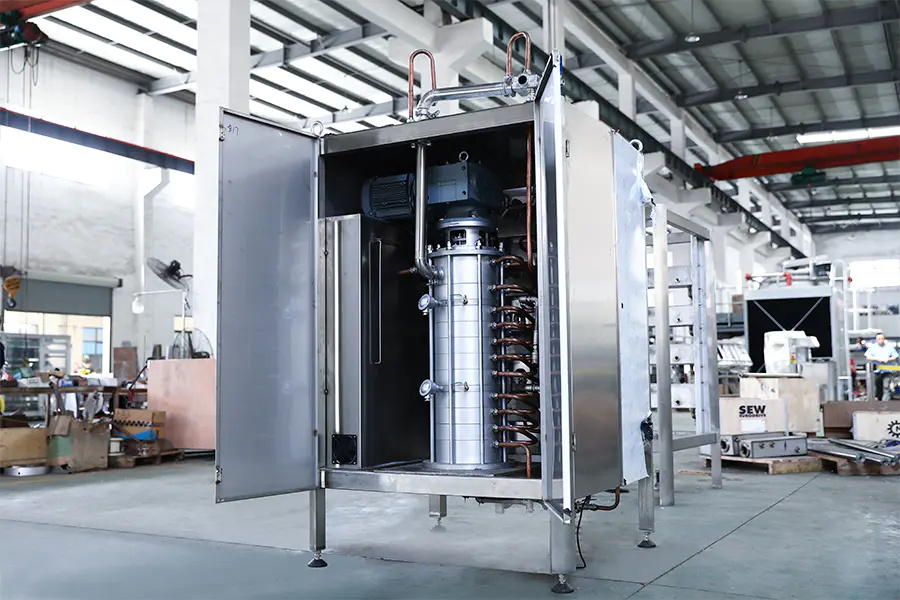The working principle of chocolate tempering machinery and equipment is based on the combination of thermodynamics and fluid mechanics. The equipment heats the chocolate to a molten state through a built-in heating device and temperature control system, and then heats the chocolate evenly through a circulation system, and finally forms a stable β-crystal structure in the cooling stage. This process requires precise control of the temperature rise and fall curve to ensure that the chocolate is in the optimal temperature range during the heating, cooling and constant temperature stages.
The core advantage of the equipment lies in the accuracy of its temperature control. Taking a certain brand of tempering machine as an example, its temperature control system can control the temperature fluctuation range within ±0.5℃, which is far more than the ±3℃ error of manual tempering. This accuracy directly determines the taste and texture of chocolate: too high temperature will cause the chocolate oil to separate, forming a rough "sand texture"; too low temperature will make it difficult to demold the chocolate, affecting the molding effect. The tempering machine ensures that the chocolate is always in the best tempering state through real-time monitoring and automatic adjustment.
In addition, the design of the equipment's stirring system is also critical. An efficient agitator can break the temperature gradient inside the chocolate and avoid local overheating or overcooling. For example, a certain model of tempering machine uses a stirring method that combines a spiral propeller with a scraper to make the chocolate tumble continuously during the flow process, and the temperature uniformity is improved by more than 30%. This uniformity not only improves the overall quality of the chocolate, but also allows each piece of chocolate to present the same color, taste and texture, ensuring the consistency and standardization of the product.
In terms of production efficiency, chocolate tempering machinery and equipment have achieved a leap from intermittent operation to continuous production. The traditional tempering method requires manual batch processing of chocolate, which takes about 30 minutes per batch, while the continuous tempering machine can shorten the processing time to less than 10 minutes. For example, a certain model of horizontal continuous tempering machine can process 100 kilograms of chocolate per hour, increasing production capacity by 200%.
The automated operation mode of the equipment further reduces manual intervention. The user only needs to preset the temperature parameters, and the machine can automatically complete the entire process of heating, stirring, cooling, etc. This "one-click" operation not only reduces the requirements for operator skills, but also reduces human errors.
The energy-saving design of the equipment is also significant. The traditional tempering method has serious heat loss, and the energy consumption accounts for up to 30%. The modern tempering machine uses insulation materials and waste heat recovery technology to reduce energy consumption by 15%-20%.
The guarantee of product quality by chocolate tempering machinery and equipment is reflected in multiple dimensions. In terms of taste, the precise tempering process makes chocolate form a delicate and silky feeling. For example, after tempering, the internal crystal structure of dark chocolate is stable, and a crisp "click" sound can be produced when bitten, which is the signature feature of high-quality chocolate. White chocolate and milk chocolate have a dense and smooth taste due to proper tempering, and the sweetness and milk flavor are perfectly blended.
In terms of appearance, the tempering machine ensures the gloss and shrinkage of chocolate. For example, the surface of tempered chocolate is as smooth as a mirror, the reflectivity is increased by 20%, and the shrinkage rate after demolding is stable at 1%-2%, avoiding the common "white frost" and crack problems under traditional tempering methods. This high-value appearance not only improves the market competitiveness of the product, but also meets consumers' expectations for exquisite food.
The application scenarios of chocolate tempering machinery and equipment have expanded from traditional candy manufacturing to baking, ice cream, catering and other fields. In the baking field, the tempering machine provides stable chocolate raw materials for cake coating, ensuring that the coating is uniform and not easy to melt.
In the ice cream field, the tempering machine provides ideal production conditions for sandwich chocolate. For example, an ice cream brand uses a tempering machine to control the hardness of chocolate, making it less likely to crack during the freezing process while maintaining a crisp taste. This innovative application has led to a 40% year-on-year increase in the brand's chocolate sandwich ice cream sales.
In the catering field, the tempering machine provides technical support for chocolate sculptures and dessert decorations. For example, a high-end restaurant uses a tempering machine to make a chocolate fountain. By precisely controlling the temperature of the chocolate, it always keeps the chocolate flowing, bringing customers a unique dining experience. This cross-border application not only expands the consumption scenarios of chocolate, but also increases the added value of the catering brand.


 中文简体
中文简体 English
English Français
Français عربى
عربى


